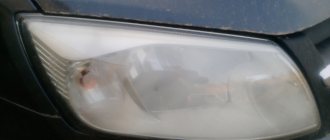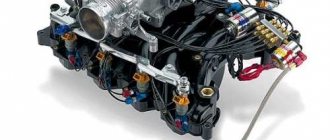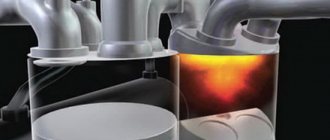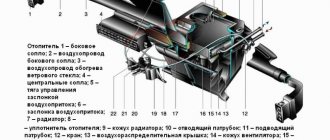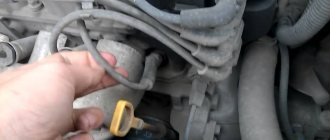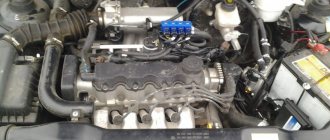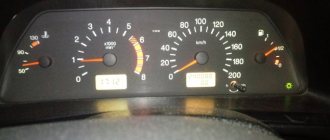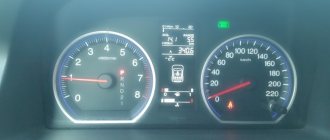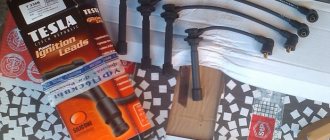Diesel went into breakdown causes of malfunction
Studying the features of the fuel supply system and mixture ignition in engines of this type helps to answer why a diesel engine is running wild.
The speed of a gasoline engine directly depends on the degree of opening of the throttle valve, through which the air necessary for the combustion of gasoline enters. The more air supplied, the more fuel will burn. As for diesel engines, the air supply in such engines is not limited, and the crankshaft speed is controlled by dosing the fuel supplied to the cylinders. Moreover, the mixture of fuel and air ignites in a diesel engine not from a spark, but from compression and heating. It turns out that the diesel engine operates as long as there is fuel in the combustion chamber.
Fuel supply and injection pump
It is quite obvious that malfunctions associated with the operation of fuel supply systems can lead to breakdown of a diesel engine. In this case, we are talking about the fuel injection pump, which is responsible for accurate dosing of fuel. In order for the diesel engine to maintain strictly specified speeds, the design uses a centrifugal regulator. This regulator limits the supply of diesel fuel when the crankshaft rotation speed increases.
Jamming of the fuel rail in the high-pressure pump leads to the engine stalling or an uncontrolled supply of diesel fuel. In the case of active fuel supply, the speed as a result of injecting more fuel spontaneously and sharply increases, the engine spins up stronger.
The fuel injection pump has a direct relationship with the crankshaft through a gearbox. An increase in crankshaft speed forces the pump to supply even more fuel, resulting in a vicious circle. As a result of this dependence of the fuel injection pump on engine speed, the pump simply fills the cylinders with diesel fuel, the diesel engine quickly reaches maximum speed and then goes into overdrive.
Engine oil entering the combustion chamber
This problem is less common than diesel runaway due to fuel injection pump malfunctions, and is also more common in diesel engines with a faulty turbocharger. The need to lubricate and cool the turbine forces designers to supply motor oil to the device. The oil is flammable at high temperatures. The high compression ratio in the cylinders of a diesel engine ensures a very high temperature at the end of the compression stroke. If there is a heavy oil leak in the turbine and it gets into the cylinders, the lubricant naturally begins to burn.
Additionally, oil can enter the cylinders through the crankcase ventilation system, since the engine crankcase is connected to the intake manifold in order to ventilate oil vapors during engine operation. Wear of the piston rings allows gases to actively break into the crankcase, the pressure of the crankcase gases increases (diesel breath), and the amount of oil vapor in the intake increases.
The combustion of oil in the working chamber causes the diesel engine to gain speed. An increase in speed increases the oil pressure in the engine lubrication system. Again, a vicious circle is created, as a result of which oil under pressure penetrates more and more intensively into the cylinders through the turbine and air filter. Diesel in this case also goes to waste.
The phenomenon of spreading
Diesel engine runaway is an uncontrolled increase in crankshaft speed. As a rule, the speed rises to the maximum level, which is a destructive force for the engine.
As you know, the speed of a diesel engine is regulated by the fuel supply. The more combustible mixture, the higher the speed. Therefore, there are two reasons for the occurrence of separation:
1.
Jammed fuel rail
2.
Malfunction of the piston rings, as a result of which oil from the sump begins to flow into the cylinders and burn.
In this situation, there are several ways to stop the engine and go for repairs.
Links
- engine spacing
- article from. - Seifert, Bill.
Offshore Sailing: 200 Essential Passagemaking Tips. —McGraw-Hill Professional, 2001.
Compression ratio of a diesel engine - what is it?
A diesel engine (in common parlance - diesel) is a piston internal combustion engine that operates on the principle of self-ignition of atomized fuel under the influence of air heated during compression. It is used mainly on ships, diesel locomotives, buses and trucks, tractors, diesel power plants, and by the end of the 20th century it became widespread on passenger cars. Named after the inventor. The first engine operating on this principle was built by Rudolf Diesel in 1897.
The range of fuels for diesel engines is very wide, this includes all fractions of oil refining from kerosene to fuel oil and a number of products of natural origin - rapeseed oil, frying fat, palm oil and many others. A diesel engine can also run on crude oil with some success.
The MiG-31 (according to NATO codification: Foxhound - fox hound) is a Soviet and Russian two-seat supersonic high-altitude all-weather long-range fighter-interceptor. Developed at OKB-155 (now PJSC RSK MiG) in the 1970s. The first Soviet combat aircraft of the fourth generation.
The MiG-31 is designed to intercept and destroy air targets at extremely low, low, medium and high altitudes, day and night, in simple and adverse weather conditions, when the enemy uses active and passive radar jamming, as well as false thermal targets. A group of four MiG-31 aircraft is capable of controlling airspace with a frontal length of up to 1,100 km.
Initially, the fighter was developed to intercept aircraft cruise missiles and the then new American B-1 bombers in the entire range of altitudes and speeds, as well as low-flying satellites and automatic drifting balloons (ADA), launched by NATO countries since the 50s over the territory of the USSR.
For several years, the MiG-31 regiments had the status of special forces (SpN) as part of the air defense.
Engine knock occurs during rapid (explosive) combustion of the fuel-air mixture in the cylinder of an internal combustion engine. To the ear it is perceived as a metallic “ringing” or knocking. This is an undesirable mode of engine operation, since increased pressure and overheating occur in the cylinder, and the cylinder structural elements experience increased loads for which they were not designed, engine power decreases, and emissions of harmful substances increase. When intensely applied, these loads quickly lead to cylinder damage and engine failure.
Engine knocking is sometimes called detonation or detonation combustion of the mixture, but this name does not reflect the physics of the phenomenon. Combustion of the mixture in an engine cylinder, both when ignited by a spark and during premature self-ignition of the mixture in hot spots, as a rule, is not accompanied by the formation of detonation waves. In accordance with the amplitude of the pressure waves that occur in the cylinder during rapid combustion of the mixture, a distinction is made between the normal combustion mode (without knocking) and the mode in which knocking occurs. The latter mode, in turn, is divided into conventional knock of varying intensity and detonation knock (super-knock or deto-knock) according to peak pressure values. Detonation knock is especially undesirable, since the pressure generated in the detonation combustion wave can immediately destroy the cylinder.
The occurrence of knocking is associated with the effects of abnormal combustion of the mixture in the cylinder: self-ignition of the mixture before it is ignited by a spark or wall ignition by hot structural elements or foreign particles in the cylinder. The likelihood of knocking increases with increasing compression ratio and engine load, as well as with decreasing fuel octane number. Electronic ignition control systems are used to prevent knocking, and anti-knock additives such as MMA (monomethylaniline) or MTBE (methyl tert-butyl ether) are added to the fuel.
How to avoid malfunction?
To avoid serious consequences, you need to monitor the performance of the injection pump.
An engine equipped with a turbine or compressor should not squirt oil or “eat” it beyond normal limits. The limit is 1 liter per ten thousand kilometers. Timely oil changes and repairs to the cylinder-piston group can reduce the risk of blowout several times. Remember that if the seal is broken, oil will enter the intake tract along with air. This mixture burns much more intensely. Therefore, the turnover will increase. And so on until the oil is completely gone. Crankcase ventilation should also be monitored. If it is poorly sealed, oil vapors enter the intake manifold. When the car's mileage is high, the piston rings are not able to remove all the film. As a result, vapors under pressure from the crankcase penetrate into the combustion chamber. It is impossible to control this process.
Reasons for separation
What is the displacement of a car engine? One of the most important characteristics of any gasoline or diesel engine is its displacement. Since the appearance of the first internal combustion engines, this characteristic of the engine has been the primary indicator, according to
There are three main reasons for diesel engine breakdown: malfunction, large quantities entering the combustion chamber through a faulty turbocharger and faulty injectors. Electric motors run out when there is a sudden loss of load, a malfunction of the control system, or a malfunction of the independent excitation windings.
High pressure fuel pump malfunction
Unlike, in which the supply of the fuel-air mixture is controlled to change engine power and speed, diesel engines are controlled by changing the amount of fuel supplied by the high-pressure fuel pump (HPF) to. The fuel injection pump is driven by the camshaft, and its performance directly determines the engine rotation speed. To maintain a given speed, it is used to limit the injection volume as the rotation speed increases. If the fuel injection pump rack jams, the chain breaks, as a result of which the engine, depending on the position of the regulator, can either stall due to insufficient fuel or go into overdrive.
Oil grab
In most vehicles, the engine ventilation is routed into the intake manifold. On a severely worn engine, gases break through the piston walls from the combustion chamber into the crankcase, pick up oil mist from the crankcase and carry it into the intake manifold. A diesel engine can run on motor oil because it contains even more chemical energy than standard oil, which is why the engine speed begins to rise. As a result of an increase in speed, the amount of oil mist captured from the crankcase also increases, and a positive positive pressure is formed. Such diesel runaway is even more dangerous, since the amount of oil mist picked up turns out to be sufficient to operate without any fuel supply at all, and the speed increases uncontrollably, since all standard control methods affect the supply from the fuel injection pump, which leads to serious accidents. To protect against operation on oil, some diesel engines (automotive, heavy, powered, etc.) have an air flap installed in the intake tract, which closes upon a signal from the limit switch.
A diesel engine can also go into overdrive if the piston burns out or if the turbine malfunctions (destruction of the shaft seals or fracture of the shaft itself). In this case, oil accumulates in the intercooler, which is not always remembered during repairs - as a result, the repaired engine can again go into disarray. Unwanted engine oil can also enter the intake manifold from leaks, high oil levels in the crankcase, or other mechanical problems. In vehicles or stationary applications that use gas-diesel engines that consume , gas leakage can also lead to spread due to its entry into the engine air intake. A similar problem exists in places containing coal dust, so all machines with diesel engines operating in coal mines must have a coal dust filter.
Electric motor spacing
Runaway can only occur with commutator electric motors. For synchronous and asynchronous motors, the rotation speed is always limited by the frequency of the supply current, and for brushless motors - by the control electronics. Occurs with a sudden loss of load: destruction of the mechanical transmission (cutting off the drive key, breakage of the drive belt), wheels (on locomotives), rupture of the stream of pumped liquid (in electric pumps).
Spacing of gas turbine engines
In some gas turbine engines, the speed of not all rotors is controlled by the speed controller, therefore, if the low-pressure compressor is destroyed (broken blades, hit by a bird), the low-pressure turbine driving it loses load and can go into overdrive. A situation is possible when a shaft break from the turbine to the load occurs before the point from which the speed regulator is driven - for example, the speed of the high-pressure rotor is controlled by the main pump-regulator, the speed of the low-pressure rotor is controlled by the OG-8-4 speed limiter, driven through the middle support - that is, from the rear support of the low-pressure compressor. Therefore, many modern engines are equipped with speed sensors located directly next to the turbine (in the “hot zone”), according to data from which the protection system turns off the engine when the last stages of the turbine are separated.
What should you do after you have stopped the diesel engine?
Even when you did everything correctly and quickly stopped the engine, try NOT to START it again under any circumstances. If this problem catches you on the road, then park your car in a safe place, turn on the emergency lights and call a tow truck. You need to take the car to a car service center, where they will study the situation in detail and determine the cause of the illness.
If your car is parked in the middle of the road and is interfering with the passage of other vehicles, then anyway, take your time and set it to the hazard lights, or better yet, try to roll it to the side of the road WITHOUT STARTING THE ENGINE!
Our video clip above clearly shows everything that can happen when an engine runs out of control, and also how some experienced motorists were able to stop an out of control engine. And friends, there is one more precaution that we want to inform you about, namely, if you try to stop the air supply to the engine directly through the turbocharger (as the American did and as shown in the second video), then please be extremely careful not to accidentally get your fingers into the turbine rotor!
The engine went into overdrive. Causes and consequences of separation.
Selection, checking and replacement of diesel engine glow plugs. Spark plugs for diesel engines
To begin with, let’s explain what the term “the engine has gone crazy” means - a spontaneous increase in engine speed to outrageous values, not controlled by anyone or anything, a kind of suicide. In most cases, before the driver realizes that the engine is going into overdrive, he will have time to either seize or show his fist, because this shocking action takes only a few minutes. This character trait is characteristic mainly of diesel engines; in isolated cases, carburetor gasoline engines ended their service using this method.
One of the reasons why the engine can go into overdrive is the wedge of the fuel rail in the injection pump, that is, fuel rushes into the cylinders without measure or limitation, and the higher the speed, the more diesel fuel enters the combustion chambers. Then everything is simple, the timing belt does not have time to react and the valves bend, the pistons melt, overheating occurs with all the ensuing consequences, and at the end of this play, either the engine breaks the crankshaft or offers to make friends, or the driver somehow manages to turn off the engine. You can jam it in different ways, either by blocking the air supply (recommended) with some object that you don’t mind, if you don’t need a hand, you can plug it with your hand, or the second method is a little longer, disconnect the fuel supply pipe. In any case, by the time you get to the air vent or fuel pipe, there is a high probability that it will still be too late. In general, I would advise getting away from the engine, which is going to pieces - it is unknown whether it will show a fist or not (experience suggests that in most cases it will), but if it does, fragments of the block will fly as if from a grenade explosion, and those who will be caught will not sweet.
A rather rare, but possible reason why an engine can go into pieces is the presence of a faulty turbine. First, a few facts: the compression ratio in the combustion chambers of a diesel engine is an order of magnitude higher than that of a gasoline engine. If a gasoline engine has an average compression of 12-16 atm, then diesel engines have a compression of 28-36 atm. High compression levels produce very high temperatures at the end of the compression stroke. At this temperature, diesel can be heated with wood. The essence of the topic is that one of the turbocharging malfunctions is oil leakage; oil, as you know, burns, and burns well. Then there’s the following scenario: one fine moment, a running turbine, leaking oil, begins to shit oil in large volumes, which cannot but please the engine. Still would! Then they feed him bread and he rushes, and then they add chocolate butter. To celebrate the doping, the engine involuntarily begins to gain speed, and as you know, the higher the engine speed, the higher the oil pressure in the lubrication system. As oil pressure increases, more and more dope flows through the turbine and air into the combustion chambers and engine speed increases. The engine is gradually deteriorating. Some will think: “Wow, my turbine is crazy!” until they see the smoke. There were cases when the engine did not stall after turning off the fuel supply, it worked purely on engine oil, not for long, of course, and at low speeds, but stably. By the way, the engines of Soviet tanks were generally multi-fuel engines, for example: a two-stroke five-cylinder boxer engine of the Soviet T-64 tank called 5TDF. The T-64 with this engine could travel 60 km on bare fuel oil, plus the 5TDF could run on kerosene and gasoline. Therefore, you should not be surprised that an ordinary diesel engine can use motor oil as fuel. Also, during a runaway, it is not uncommon for the crankshaft to break in half, but the engine can also operate with a broken crankshaft, albeit with a characteristic knocking noise.
In my life, I have only twice seen in reality how an engine goes into disarray and both were YaMZ 238 on K-700 tractors. So, the impressions are quite peculiar. At the beginning, you can hear the quiet operation of the engine, then suddenly the tractor suddenly picks up speed, the roar of the engine and the wild whistle of the turbine put you into a stupor. But before I had time to understand anything, I heard an explosion, it was it - the fist of friendship. Then suddenly there was silence... The KAMAZ engine went into disarray. Consequences.
Watch the video YaMZ 238 goes to pieces.
{webplayer width=690 height=400 type=youtube video=https://www.youtube.com/watch?v=84BqPFFvRgI}
Reasons – fuel injection pump
One of the main reasons for this phenomenon is a malfunction of the high-pressure fuel pump or rack. As a result, fuel enters the combustion chamber without restrictions. This is an uncontrolled process. And the more of it gets into the chamber, the higher the engine speed. After this, the gas distribution mechanism (often with a chain drive) does not have time to react to these changes. As a result of incorrect phase distributions, the crankshaft, intake and exhaust valves bend. The consequences in most cases are very sad. What to do if the engine breaks down?
There is only one way to save the unit - shut it down. But it is not always possible to do this with a key. You have to independently block the access of air to the combustion chamber. But in some cases, the diameter of the inlet intake hole is very large. And even with improvised means it will not be possible to close it. Air will still flow through small cracks. It is worth noting that on passenger cars the oxygen intake is located at the bottom. Therefore, you will have to cut off the supply after the air filter. To do this, unscrew the clamp with a screwdriver and stop the oxygen supply to the pipe. This needs to be done as quickly as possible. Remember that minutes count here. The second option is longer, but effective. If the engine starts to spin, it is necessary to stop the fuel supply by disconnecting the fuel line. But there is not always time for this. The consequences are bent valves and a failed crankshaft. The worst thing is that at this time fragments of the cylinder block are flying. The explosion can be compared to the effect of a grenade. It is simply dangerous to be near such a motor. But this does not happen immediately, but after 3-5 minutes of engine operation in this mode.
Spacing - engine
Engine runaway is a phenomenon in which the number of shaft revolutions continuously increases until the flywheel and other components are destroyed.
Engine runaway can occur due to a faulty regulator, which cannot reduce the stroke of the pump plunger and, consequently, the fuel supply. It is necessary to carefully monitor the operation of the regulator and stop the engine immediately if there is a malfunction.
Engine runaway can also occur if a large amount of fuel enters the cylinder during startup.
| Electrical diagram of the STE-40-1500 stand. |
Engine runaway is possible during run-in with a load in the event of an involuntary shutdown of the electrical machine or a voltage drop without warning.
What is engine runaway and when does it occur?
To prevent engine runaway at idle, many hand-held machines with rotary pneumatic engines are equipped with centrifugal regulators, thanks to which, when the rotation speed increases, the supply of compressed air into the working cavity of the rotor is stopped or reduced, thereby reducing the engine speed. To reduce the rotation speed of a rotary motor to the required spindle speed, manual pneumatic machines use planetary gearboxes.
| Mechanical characteristics at.| Adjustment characteristics for pole control. |
The best guarantee against engine runaway is the presence of a constant moment of resistance on its shaft, eliminating the possibility of the engine running idle.
In mechanisms of this kind, engine separation is impossible due to a rigid connection using a gear drive.
The limiter is especially important in that it prevents engine runaway when operating without load.
Oil from line 12 enters the maximum automatic 13, which prevents engine runaway. When the spool is in the lower position, oil from the maximum automatic machine enters the locking device 14 and can then enter the servomotor when the locking spool is lowered to the lower position. When the spool is in the upper position, the cavity of the servomotor is connected to the drain line, its piston is lowered and turning on the fuel supply with the fuel handle is impossible.
| Dependence of speed on voltage for a motor with independent excitation.| Scheme for regulating the speed of a motor with parallel (independent, excitation).| Characteristics of a motor with parallel excitation. a idle speed characteristic. b adjustment. |
Reducing the excitation current below a certain limit leads to unstable operation and the possibility of engine runaway.
This pressure drop with a sharp increase in shaft rotation speed (for example, when the engine is running apart), as a rule, leads to rupture of the oil layer in the bearing, the appearance of semi-dry friction and, as a consequence, to excessive heating and jamming of the crankshaft in the bearings, as a result of which the engine fails.
Turbine
Diesel can go bad for a variety of reasons. If it is a turbocharged engine, there is a high probability that this happened precisely because of this mechanism. This element is cooled by oil. Sometimes leaks occur. As a result, the mechanism is unable to provide boost. Engine speed involuntarily increases. As they increase, the oil pump begins to pump lubricant faster. As a result, it ends up in the combustion chamber. Black smoke comes out of the exhaust pipe.
With such a malfunction, the unit may be left without lubrication altogether. After all, all the oil went into the exhaust pipe. There have been cases when, even after turning off the fuel supply, the unit continued to operate purely on lubricant. And even if this process lasts no more than a minute, this is quite enough for the diesel to go to waste. This happens especially often on older military engines. They are designed for the consumption of fuel oil and kerosene. Therefore, you should not be surprised that after stopping the fuel supply, the engine continues to work. If the diesel engine goes into overdrive, the crankshaft may burst in half. It is not necessary that it will tear out the cylinder block and fly out with fragments. In some cases, the engine will continue to operate, but with characteristic knocking noises. What else happens when diesel goes into overdrive? As the speed increases, the engine temperature increases. It overheats quickly. Also, if it is a leak from the turbine, fires are possible in the exhaust manifold area. Piston jamming occurs in a matter of minutes. Moreover, it does not matter what the current inertia force of the flywheel is. Even if the car is idling, the connecting rod bolts and other elements of the crank mechanism (crank mechanism) may break.
Got into trouble
Examples of the use of the word peddling in literature.
Of course, the ball in the Mabille garden is not the Polymnian dances on the Janiculum Hill, but the haberdashery peddler is stalking the lorette there, just like Staphilus's pimp, the virgin Planesia.
Willis and Zimmer turned off the engine, which had gone haywire, and P.G. began lowering the rocking helicopter, glad that they had only climbed fifty feet.
Seeing, however, that the noblewoman was not angry, Demid spoke more briskly: “A small merchant often peddles his trade from a German.”
Then the moment comes when the Executor realizes that all his desires are coming true - and, one might say, he walks away, intoxicated with his own power.
Yes, and all trade from the Germans goes through us, and in the volosts we also sell German goods ourselves!
They also include peddlers, day laborers, small businessmen and company managers, as well as successful, very wealthy entrepreneurs.
Ten years ago I was peddling and carrying a suitcase from house to house.
During the war, he was a peddler, even without a patent, a tramp, illegally selling textile goods, a small speculator, wandering from village to village, either by train or on foot, walking kilometer after kilometer of country roads, through dense forests to remote farms, with a dirty leather bag behind his shoulders, or even with a basket or dilapidated suitcase in his hand.
Finally I heard my heart begin to pound decisively, the blood rushed to my face, and sweat appeared.
In most cases, the rockets exploded from the bottom and side of the engines, the destroyed turbine and compressor went wild and the blades flying in all directions chopped up everything in their path worse than shrapnel.
This incident had tragic consequences - while going on a control flight after repairs, Major Kozovoy came under fire from the DShK, the tail rotor with a shot off blade went haywire, the damaged tail boom collapsed, and the out-of-control vehicle collapsed, burying the entire crew.
The reasons were in Moscow, as Mikhalych explained, wincing, after reading out the order about the failure of the next Panjshir operation, that the civilians were peddling the military machine.
Ipat left the hospital earlier and went to the front again, and Nikon, having met October in Moscow, decided to save some money before returning to the village and took up peddling.
At the beginning of the next summer, when she was again blissfully jogging through the Ilyichevsk hills and forests, Denis and Anton were filming location in the Baltic States, her mother-in-law was in the hospital, and Philip, instead of going crazy in an empty apartment, suddenly became interested in radio engineering and became make decent money by turning your room into a workshop.
The most unpleasant thing that can happen on a nuclear ship happened - the reactor went haywire, approaching an uncontrolled regime, which naturally culminates in a super-powerful explosion.
He went wild
What to do if the diesel engine goes bad
The most correct decision would be to completely abandon attempts to turn off the engine, which has gone to pieces.
We should not forget that engine breakdown often ends in a split of the cylinder block and/or cylinder head. As a result of such damage, fragments fly away at high speed, which is a threat to life. The danger of engine overrunning lies in the fact that the driver does not always have time to notice in a timely manner the beginning of an uncontrolled increase in speed. If the diesel engine has just started to run out in a car that is standing still, then you can try to turn off the engine.
If you nevertheless decide to try to save a diesel engine that has gone to pieces, then there are two ways:
The simplest solution is to cut off the air supply with improvised objects. You need to plug the air duct in the air filter area. It must be separately taken into account that at the time of engine separation the temperature under the hood is extremely high, so there is always a risk of burns, injuries or fire.
The second option is the method of disconnecting the fuel supply line/pipes, which also requires experience, knowledge of the internal combustion engine structure and extreme caution. If you are not confident in your abilities, then it is better not to open the hood and completely abandon any attempts to turn off the engine, moving away from the car to a safe distance.
To summarize, it should be added that often there is not enough time to stop the supply of air or fuel to the cylinders in a timely manner. Car owners simply do not have time to prevent jamming or destruction of the internal combustion engine.
Blue diesel exhaust, faults and causes of blue diesel exhaust. Wear of the cylinder-piston group, compression, diesel fuel supply.
Diesel engine exhaust is black. Soot from a diesel exhaust pipe, causes of incomplete combustion of fuel. Determination of main faults.
Why does a diesel engine smoke white exhaust? White diesel exhaust “when cold” and after warming up the engine. Main causes, fault diagnosis.
Causes of difficult “cold” starting of a diesel engine. Compression, glow plugs, diesel injectors, injection pump, paraffin or water in the fuel system.
Causes of white, bluish, blue and black smoke from a cold and warm engine. Diagnostics based on the color of exhaust gases. How to find the reason yourself.
Why does the engine smoke black after starting? Causes of white smoke or blue exhaust gases. Diagnostics of faults, recommendations.
Source
Why does a diesel engine go bad?
Although history knows several cases when a gasoline carburetor went bad, this problem still remains the lot of diesel units. Every owner of a diesel car has heard horror stories about how a “friend of a friend’s” engine began to uncontrollably and spontaneously increase speed to a practical maximum, as a result of which the power plant simply collapsed. Why does this happen and how can this be avoided?
Signs and consequences of a malfunction An engine that has gone into overdrive exhibits several unambiguous symptoms: - an increase in speed to the limit when the gas pedal is released, - the engine does not stop working even when the ignition is turned off, - very loud noise from a running engine, - thick black smoke and soot, like burning rubber coming from the exhaust pipe (sometimes even accompanied by flashes of flame). If you do not quickly turn off the engine, the consequences of this malfunction will be the most catastrophic. Firstly, the engine will overheat greatly, which in itself is fraught. Secondly, due to overheating and deterioration of lubrication, one of the moving units will jam, which will lead to its destruction. Typical consequences include destruction of parts of the pistons, connecting rods, crankshaft, melting of valves and pistons, as well as other equally dramatic consequences. Sometimes a diesel engine that has gone into disarray can explode in the literal sense of the word, which threatens the almost complete destruction of everything in the engine compartment and the scattering of fragments outside the car. A car fire cannot be ruled out.
Causes of malfunction Unlike a gasoline engine, in a diesel engine the fuel is not forcibly ignited by a spark, but by powerful compression, and the volume of incoming air is in no way limited by the throttle valve. In a diesel engine, the crankshaft speed is regulated only by dosing the fuel entering the engine. In other words, the diesel engine will work as long as fuel is supplied to it. From the above it follows that malfunctions in the fuel supply system are the main reason for the breakdown of the diesel engine. To be precise, the problem lies in the high pressure fuel pump, which meters the fuel supply. It has a centrifugal speed controller, which should limit the fuel supply as the crankshaft speed increases. And if this regulator jams, then one of two things can happen: the engine will stall due to the cutting off of fuel supply, or it will go into overdrive due to the continuous supply of diesel fuel. However, that's not all. Since the injection pump is directly connected to the crankshaft through a gearbox, the more the crankshaft spins, the more fuel the pump pumps into the engine. The circle closes and what owners of diesel cars like to scare each other with begins. Hence the conclusion: if you don’t want the Cummins engine in your car to go to pieces, maintain the car in a timely and efficient manner, including the fuel system.
How to turn off the engine while running? The worst thing in this situation is that simply releasing the gas pedal and turning the ignition key to the first position will not achieve anything. The engine will still continue to run, since its operation is no longer regulated by the car's controls. If the runaway starts while stopping, you're in luck. You have the opportunity to save the engine if you quickly shut off the fuel or air supply to the engine. To do this, just tightly plug the air duct in the area of the air filter with a rag. But you should only turn off the fuel line if you know exactly how to do it. If engine overshoot catches you while driving, an increase in speed will immediately lead to an uncontrolled increase in speed. In this case, you need to disengage the clutch and take emergency precautionary measures. The main task is to stop the car quickly and safely. Only after this, if there is time, can you begin the actions described above to save the motor.
Action plan in case of engine malfunction
Many motorists have already developed a specific action plan that is recommended to be carried out in the event of equipment breakdown.
- If for some reason the engine speed begins to increase sharply, then it is necessary to turn off the ignition and gear. Very often the driver does not always have time to notice the increase in speed. At the initial stage of their growth, it is possible to turn off the engine in the usual way.
- If possible, move to the side of the road;
- If necessary, open the hood to gain access to the air intake;
- It is recommended to turn on the hazard lights;
- The air intake hole must be covered with thick cloth. Truckers use sweatshirts for these purposes. If there is a carbon dioxide fire extinguisher in the car, then use it. The jet is directed into the air intake. Since this gas is not flammable, the powerful flow will cause the engine to “choke,” which will lead to its stop;
- You can no longer start the engine. Otherwise, the car owner will see his engine die. The car is transported to the repair shop either by tow or by tow truck.
If for some reason the driver cannot perform these manipulations, then he should move a short distance from the car and start calling specialized services for help.
If you carry out the above steps in time, this will lead to the fact that only engine repair will be required, and possibly replacement of the turbocharger. However, there will be no other serious consequences.
Experts do not recommend repairing equipment on your own, because the slightest flaw will lead to the situation with the breakdown repeating. It is best to repair a diesel engine in specialized centers. Therefore, you should not skimp on the work of professionals, so as not to pay twice.
Such phenomena still happen during the operation of the car, so owners are interested in the reasons why the engine is running wild. Most of the cases occur in diesel engines, especially those that were produced many years ago. Modern engines, in addition to the driver, are also controlled by on-board computers, which carefully monitor the operating conditions of the power unit, do not give it excess fuel, and do not allow an uncontrolled increase in crankshaft speed.
